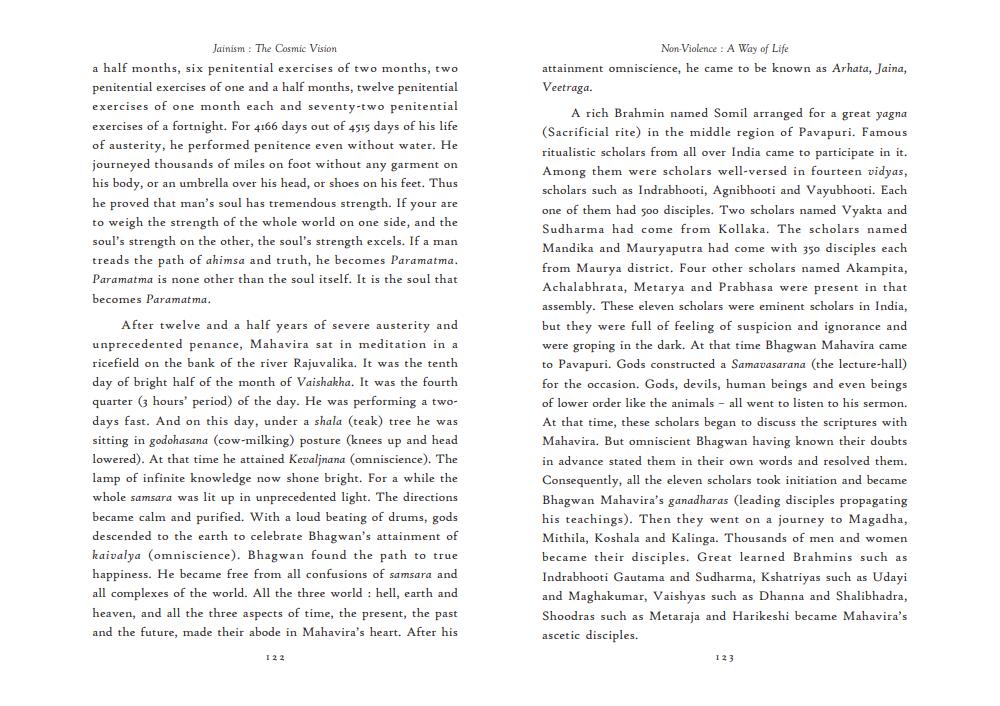________________
Jainism: The Cosmic Vision a half months, six penitential exercises of two months, two penitential exercises of one and a half months, twelve penitential exercises of one month each and seventy-two penitential exercises of a fortnight. For 4166 days out of 4515 days of his life of austerity, he performed penitence even without water. He journeyed thousands of miles on foot without any garment on his body, or an umbrella over his head, or shoes on his feet. Thus he proved that man's soul has tremendous strength. If your are to weigh the strength of the whole world on one side, and the soul's strength on the other, the soul's strength excels. If a man treads the path of ahimsa and truth, he becomes Paramatma. Paramatma is none other than the soul itself. It is the soul that becomes Paramatma.
After twelve and a half years of severe austerity and unprecedented penance, Mahavira sat in meditation in a ricefield on the bank of the river Rajuvalika. It was the tenth day of bright half of the month of Vaishakha. It was the fourth quarter (3 hours' period of the day. He was performing a twodays fast. And on this day, under a shala (teak) tree he was sitting in godohasana (cow-milking) posture (knees up and head lowered). At that time he attained Kevaljnana (omniscience). The lamp of infinite knowledge now shone bright. For a while the whole samsara was lit up in unprecedented light. The directions became calm and purified. With a loud beating of drums, gods descended to the earth to celebrate Bhagwan's attainment of kaivalya (omniscience). Bhagwan found the path to true happiness. He became free from all confusions of samsara and all complexes of the world. All the three world : hell, earth and heaven, and all the three aspects of time, the present, the past and the future, made their abode in Mahavira's heart. After his
Non Violence : A Way of Life attainment omniscience, he came to be known as Arhata, Jaina, Veetraga.
A rich Brahmin named Somil arranged for a great yagna (Sacrificial rite) in the middle region of Pavapuri. Famous ritualistic scholars from all over India came to participate in it. Among them were scholars well-versed in fourteen vidyas, scholars such as Indrabhooti, Agnibhooti and Vayubhooti. Each one of them had soo disciples. Two scholars named Vyakta and Sudharma had come from Kollaka. The scholars named Mandika and Mauryaputra had come with 350 disciples each from Maurya district. Four other scholars named Akampita, Achalabhrata, Metarya and Prabhasa were present in that assembly. These eleven scholars were eminent scholars in India, but they were full of feeling of suspicion and ignorance and were groping in the dark. At that time Bhagwan Mahavira came to Pavapuri. Gods constructed a Samavasarana (the lecture-hall) for the occasion. Gods, devils, human beings and even beings of lower order like the animals - all went to listen to his sermon. At that time, these scholars began to discuss the scriptures with Mahavira. But omniscient Bhagwan having known their doubts in advance stated them in their own words and resolved them. Consequently, all the eleven scholars took initiation and became Bhagwan Mahavira's ganadharas (leading disciples propagating his teachings). Then they went on a journey to Magadha, Mithila, Koshala and Kalinga. Thousands of men and women became their disciples. Great learned Brahmins such as Indrabhooti Gautama and Sudharma, Kshatriyas such as Udayi and Maghakumar, Vaishyas such as Dhanna and Shalibhadra, Shoodras such as Metaraja and Harikeshi became Mahavira's ascetic disciples.
123




